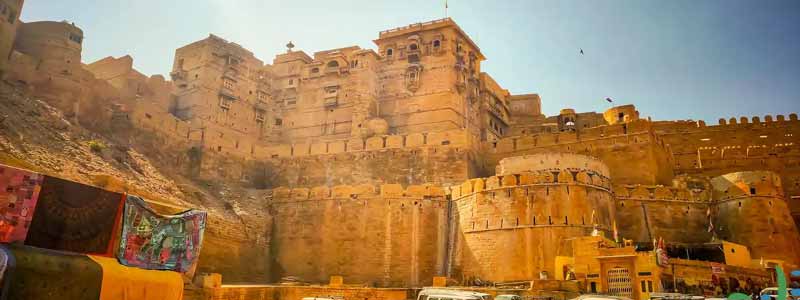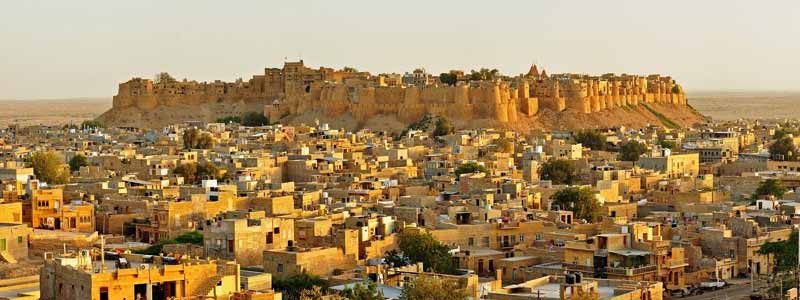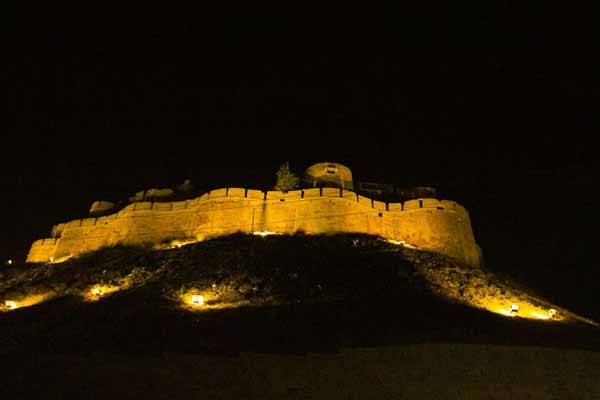Sonar Quila Jaisalmer Fort sometimes also referred to as the ‘Golden Fort’ is an excellent example of architectural brilliance. This fort in the Thar Desert of Rajasthan, built in 1156 AD by Raja Jaiswal, is also the essence of artwork blended in military splendour. This massive structure has been the site for many major battles. Jaisalmer Fort, one of the largest forts in the world, is situated on the Trikuta hill in the heart of Sonar Quila Jaisalmer.
The sun with its brilliant dazzling rays, give an excellent tawny appearance to the fort during the day that changes to a bright golden in the evening with the rays from the setting sun striking it. At night the fort camouflages with its sandstone walls in the sandy Thar Desert Sonar Quila Jaisalmer.
The fort was built by Raja Rao Jaiswal, a Bhatti Rajput ruler in order to secure his capital from threats of invasion. The capital was previously located in Lodurva, which was shifted from there with the creation of the ‘Sone ka Quila’ or the Golden Fort. This fort’s structure was massive and mighty that was capable of protecting the new capital of the Bhatti Rajput ruler. After the Chittorgarh fort this is the oldest fort in Rajasthan that still exists even at the present.

History of Jaisalmer Fort
Jaisalmer Fort (Sonar Quila) seems to arise out of the vast sandy plains of the Thar Desert like a colossus, mesmerizing onlookers with its mighty structure and awesome power.
Built almost 800 years ago, in 1156 AD, its yellow sandstone walls and massive fortifications have withstood brutal enemy attacks and weathered the harshness of extreme climatic changes Jaisalmer Tour Packages.
The fort flourished along the ancient trade routes that passed through Sonar Quila Jaisalmer, and is considered among the world’s largest forts… so large that it accommodates a sizable population even today, almost 4000 people, who live in mansions inside the fort.
Today, Jaisalmer fort is a UNESCO World Heritage Site & is best to look at in the evenings, when it glows with a golden glow, and at night, when lights illuminate the entire fort, making it look surreal, against the backdrop of a dark night sky.

The architecture of the fort
You will be learning more about the architectural depth; the fort carries within its whim. The Fort is 1,500 meters high and 750 meters wide. It was built at the elevation of 250 meters above the hill-top. This is how one can view the fortification of the walls, even from the surrounding countryside areas. The base of the fort is 15 feet tall. This covers the fort’s outer-most ring. One gets a mesmerizing view of the triple-ringed defense architecture.
Now, let us have a look into bastions or towers of the Sonar Quila Jaisalmer. Each bastion or the tower of the fort has an inner perimeter spanning 2.5 mi or 4 km long. The fort now has 99 such towers or bastions. Almost 92 of them were built during 1633-47. It is therefore incredible to know how the archeological remains of the fort stay intact, till date. The four entry gates that lead you into the fort’s premises look magnificent and enchanting Jaisalmer Monuments.
Best Season to Visit Jaisalmer
From October to March is considered to be the best time to visit Jaisalmer since the climate during this period is pleasing. Located in the center of the Thar Desert, the summer season is tremendously hot and dry and thus one must avoid it.
The heatwave will certainly heat up your body, and thus you won’t be able to appreciate your tour to the fullest. However, during the winter season, the temperature rate falls up to 1 °C or 2 °C, particularly at night time, so carrying warm cloth is compulsory.
During the monsoons, it is a decent time to make a trip to Sonar Quila Jaisalmer. At this point in time, you may also get a sight of some greenery rising on the dry turf. Jaisalmer is a vibrant and colorful place with an even more attractive culture. So, let’s now see the season-to-season details…
